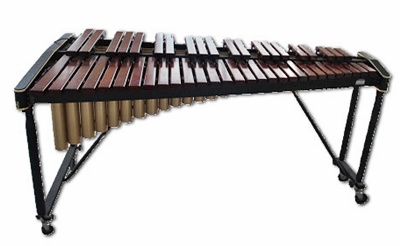Musical Instruments
| Timpani | Drum Set | Gong | Cymbal | Triangle |
| Xylophone | Glockenspiel | Bass Drum | Snare Drum | Tambourine |
Xylophone
 Xylophone are percussion instruments, which are made by putting the wooden keyboards on the resonators. Xylophone players strike the xylophone with mallets. The arrangement of keyboards on xylophones are similar to the piano. Generally, xylophones refer to xylophones with high pitch, narrow keyboards, high pitch and clear sound. The marimba is also a kind of xylophone.
Xylophone are percussion instruments, which are made by putting the wooden keyboards on the resonators. Xylophone players strike the xylophone with mallets. The arrangement of keyboards on xylophones are similar to the piano. Generally, xylophones refer to xylophones with high pitch, narrow keyboards, high pitch and clear sound. The marimba is also a kind of xylophone.
The origin of xylophones is still unsure. The earliest record of xylophones appeared in the 9th century. People then already arranged wooden sticks on racks and stroke them with clubs. For instance, xylophones were found in gamelon music in Indonesia. And balafons are used in Africa by whittling the top of gourds and cover the gourds on wooden sticks as resonators, which could be thought as ancestors for modern xylophones.
The structure of xylophones could be divided as
Keyboards
As its name suggested, the keyboards of xylophones are made of woods. Red woods are the most frequently used, and sometimes better kinds of woods such as purple sandalwoods are also used. These two kinds of woods are stronger in texture and could make louder and more solid sounds. Furthermore, they are cheaper than logs. However, they lack the unique echo and vibration of woods, which are the spring power made by natural fibers. The difference may not be intellegible to the general audience but is obvious for professional players.
The cut woods would be chained with rubber and would be fixed on hooks.
Frame
The frames of the xylophones would differ according to their size, accessories and other factors. Thinner xylophones are not equipped with legs while larger ones are attached with wheels to enable mobile movements.
Tube resonator
Keyboards of the xylophones are put on resonators. Kids play the xylophone to learn msic.
Due to the dry and short echoes of the xylophone sounds, resonators are actually not effective. Therefore, resonators are not set in early versions of xylophones. Recently, influenced by marimbas or vibraphones, resonators are set on xylophones with three or three and a half octaves. Resonators are longer in bass, and they are shorter in treble or even without resonators.
Musical Notation
Xylophones use treble clefs for notation. It is a transposing instrument. An xylophone with three octaves, marking as F3 to C6, which is actually an octave higher.
(Please move your mouse to the left corner in the video and click play bottom to watch.)
Xylophones, performer: Yu-Xuan Liang
Do you want to learn more?
![]() Interview with concertmasters
Interview with concertmasters
![]() Yi-Xuan Lin, xylophone and glockenspiel concertmaster
Yi-Xuan Lin, xylophone and glockenspiel concertmaster
